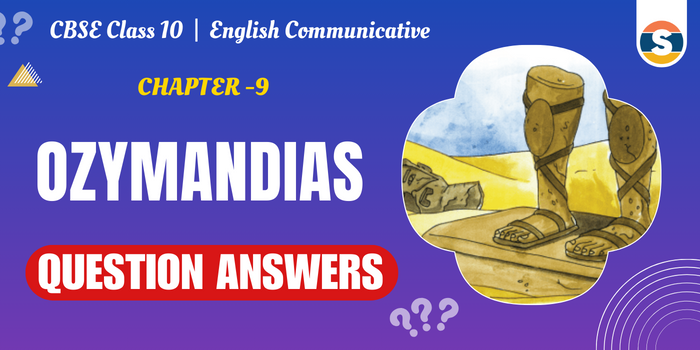CBSE Class 10 English Chapter 9 Ozymandias Question Answers (Important) from Literature Reader (Communicative) Book
Looking for Ozymandias question answers for Class 10 English Communicative- Interact in English Chapter 9 (Poem)? Look no further! Our comprehensive compilation of important questions will help you brush up on your subject knowledge. Practising Class 10 English Communicative question answers can significantly improve your performance in the exam. Our solutions provide a clear idea of how to write the answers effectively. Improve your chances of scoring high marks by exploring Poem: Ozymandias now. The questions listed below are based on the latest CBSE exam pattern, wherein we have given solutions to the chapter’s extract based questions, multiple choice questions, short answer questions, and long answer questions.
Also, practising with different kinds of questions can help students learn new ways to solve problems that they may not have seen before. This can ultimately lead to a deeper understanding of the subject matter and better performance on exams.
Ozymandias Question Answers – Book Questions, Extra Questions
- Ozymandias Book Questions
- Ozymandias Extract Based Questions
- Ozymandias Short Answer Questions
- Ozymandias Long Answer questions
Related:
- Ozymandias Class 10 English Summary, Explanation, Difficult Words
- Ozymandias MCQ
- Ozymandias Previous Years Question with Answers
Book Questions
1. Look at the picture given below.
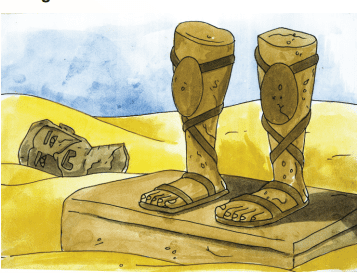
While on a sight-seeing tour to an old and mysterious country far away from home, you have had seen this statue. Discuss with your partner what this picture tells you about the people, the place and the ruler. Note down your ideas in the web-chart.
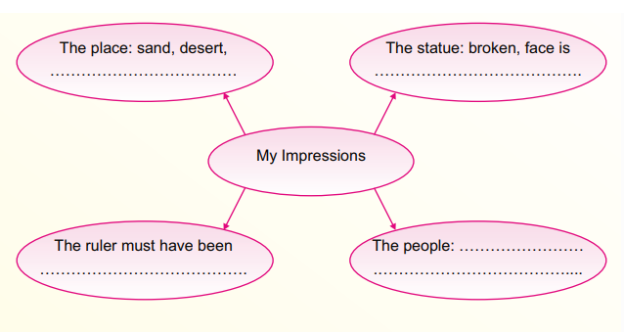
Ans-

2. Write a letter to your friend about the sight you saw and your impression of it. You may create necessary details.
Ans-
12, Malviya Nagar
Indore
24 May, 2023
Dear Shloka,
Earlier this year, I visited Bhangarh. As I left the town, I came upon two enormous stone legs in the desert that were standing without a trunk. It came as a welcome surprise to find such a huge building in the middle of nothing. A broken face that was partially buried in the sand was laying very close to their legs. I drew nearer and made an effort to analyse the facial expressions. It was stamped with feelings of disdain and icy power. It was the haughty, smug look of a man’s face. When I looked at the writing on the statue’s pedestal, the mystery became evident. The statue was of Ozymandias. He was described as ‘the king of kings’. He must have been a very powerful king. He must have held all other mortals in lower regard.
The pedestal read : “Look upon my works, ye Mighty, and despair”. But alas! His symbols of grandeur and glory are reduced to dust. His broken face and broken statue are partially buried in an infinite stretch of bare sand.
Yours sincerely
Preeti
3. Answer the following questions by selecting the correct options.
(a) The poem is set in _________________ .
(i) the wilderness
(ii) an ancient land
(iii) a palace
(iv) a desert
Ans- (iv) a desert
(b) Select the option that includes the set of qualities that the poet attributes to Ozymandias, in the given extract.
(I) boastful, furious, manipulative
(ii) ruthless, arrogant, desperate
(iii) haughty, self-serving, contemptuous
(iv) ambitious, aggressive, cruel
Ans- (iii) haughty, self-serving, contemptuous
(c) In the line, “My name is Ozymandias, king of kings”, the poet makes an indirect reference to an ancient empire to remind readers that_________________.
(i) Time can be conquered
(ii) humility is a great virtue
(iii) the glory of the king is everlasting
(iv) a monarch’s power is ephemeral
Ans- (iv) a monarch’s power is ephemeral
(d) The words ‘bare’ and ‘decay’ indicate that the mighty ruler has become____________.
(i) obscure
(ii) defenceless
(iii) dejected
(iv) indestructible
Ans- (i) obscure
(e) The tone of the poem is ________________.
(i) mocking
(ii) nostalgic
(iii) gloomy
(iv) gloating
Ans- (i) mocking
4. Answer the following questions briefly.
(a) “Look on my works, ye Mighty, and despair!” Who is Ozymandias referring to when he speaks of ‘ye Mighty’? Why should they despair?
Ans- All subsequent kings and queens who will reign after the King Ozymandias are referred to here. He says they can’t match his splendour and might, therefore they should be sad and give up.
(b) Bring out the irony in the poem.
Ans- The irony of “Ozymandias” cuts much deeper as the reader realises that the forces of mortality and flexibility, described brilliantly in the concluding lines, will wear down and destroy all our lives. There is a special justice in the way tyrants are subject to time, but all humans face death and decay. The pedestal’s claim that onlookers should despair at Ozymandias’s works thus takes on a new and ironic meaning: one despairs not at Ozymandias’s power, but at how powerless time and decay makes everyone, even the statue has been destroyed by time.
(c) The poem re-emphasizes the idea that political power is transient but art is eternal and it survives. Do you agree? Why/ Why not?
Ans- Yes, I agree that political power is transient but art is eternal. The fact that even this “king of kings” lies decaying in a distant desert suggests that no amount of power can withstand the merciless and unceasing passage of time. Yet even as the poem insists that “nothing beside” the shattered statue and its pedestal remains, there is one thing that actually has withstood the centuries: art. The skillful making of the statue itself and the words carved alongside it have survived long after Ozymandias and his kingdom turned to dust, and through this Shelley’s poem positions art as possibly the most persistent tool in preserving humanity’s legacy.
(d) Overarching ambition can lead to great leaders and their downfall. Substantiate your position in favour or in opposition to this statement.
Ans- I agree that Overarching ambition can lead to downfall of a great leader too.
When one is too ambitious, ambition gets the better of a person. For example, in the poem Ozymandias, the king/ruler probably became too concerned with his power and immortality and he became delusional that he too will perish.
(e) ‘Nothing beside remains.’ What does the narrator mean when he says these words?
Ans- The narrator highlights the reality that human life is time-bound when he uses these words. Along with the ruler’s descent came a decline in both the ruler’s authority and popularity. In this universe, nothing is both immortal and permanent.
(f) What message is conveyed through this poem?
Ans- This poem makes a very profound reference to the central truth of human existence—that nothing matters. Everything in our universe is finite and not everlasting. The enduring character of time and existence has been made clear via this poem.
5. Identify and rewrite the lines from the poem spoken by the narrator, the traveller and Ozymandias. What impact do your think these three voices have on the reader?
The Narrator: ________________________________________________________
___________________________________________________________________
___________________________________________________________________
The Traveller: ________________________________________________________
___________________________________________________________________
___________________________________________________________________
Ozymandias: ________________________________________________________
___________________________________________________________________
___________________________________________________________________
Ans-
The Narrator: The narrator introduces the poem by explaining how the traveller described his journey to the ancient land.
The Traveler: In the desert, there were two enormous statues that were missing their upper bodies. A broke face with a scowl and a wrinkled look was lying close to them. Additionally, the face had a chilly, aggressive look of authority. The talent of the sculptor allowed one to interpret the expression on these dead objects quite clearly. The king’s own words were written on the pedestal. He was described as Ozymandias, King of Kings, who compelled the coming rulers to gaze up to him and feel dejected because they could never match the magnificence he had attained.
Ozymandias:I am Ozymandias, king of all kings; feel discouraged by my might, which you can never equal, while you observe my creation.
6. Shelley’s sonnet follows the traditional structure of the fourteen-line Italian sonnet, featuring an opening octave, or a set of eight lines, that presents a conflict or dilemma, followed by a sestet, or a set of six lines, that offers some resolution or commentary upon the proposition introduced in the octave. Read the poem carefully and complete the following table on the structure of the poem.

Ans-
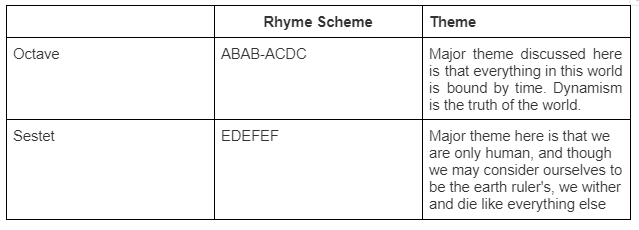
7. Complete the table listing the poetic devices used by Shelley in Ozymandias.

Ans-
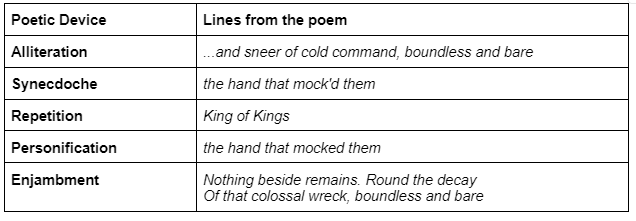
8. Imagine that Ozymandias comes back to life and as he sees the condition of his statue, realisation dawns on him and he pens down his thoughts in a diary. As Ozymandias, make this diary entry in about 150 words. You could begin like this:
I thought I was the mightiest of all but…
Ans-
Wednesday, 24 May 2023
9.30 PM
Dear Diary,
I was greatly misguided in thinking that I was the strongest of all. I now see how useless my might and power are against the passage of time. Being told that my command is useless makes me sad. The force of reality and nature is far greater than I had imagined. I’ve finally realised that everything on this planet will change, regardless of any individual characteristics or preferences. I’ve now accepted the truth that, although I may have been a brilliant ruler, bragging about it was wrong. Therefore, I believe that one should be humble and realistic about oneself.
Ozymandias
9. ‘Ozymandias’ and ‘Not Marble, nor the Gilded Monuments’ are based on the theme of Time. Compare the two sonnets in terms of the manner in which Time is treated by the poets. Write your answer in about 150 words.
Ans-
Both sonnets speak about time’s influence and power over all living things. Time is the all-powerful, eternal ruler which rules over everything.
Shakespeare praises poetry and art in the sonnet “Not Marble Nor the Gilded Monuments.” He claimed that while time and violence may destroy everything, poetry and art could not. Since the dawn of civilisation, many bloody conflicts have been waged around the world. In such conflicts, towns, cities, kingdoms, and nations were annihilated. However, poetry and art were not destroyed by time; they are still in existence today. In the sonnet “Not Marble Nor the Gilded Monuments,” the author decides to immortalise his companion. He claims that neither death nor an adversary will be able to influence his friend’s fate, and neither will be able to hurt him in any way. The future generations will learn about and appreciate his heroic actions. Reading the poet’s rhymes would help future generations of people keep the memory of his loving and compassionate gestures in their minds. So, until the Day of Judgement, his friend’s remembrance will endure forever.
P.B. Shelley discusses the omnipotence of time in the poem “Ozymandias.” The mightiest of rulers, such as Ozymandias, and all of their kingdoms, can be reduced to rubble and ashes. The poet does not discuss the longevity of poetry or any other creative form in this poem. Shakespeare’s work, nevertheless, shows that poetry has greater power than time.
10. ‘None are so empty as those who are full of themselves.’ Compare and contrast the characters of Mrs. Packletide and Ozymandias in light of this statement.
Ans- Both the characters are vain and full of themselves. The character of Mrs. Packletide was very selfish and greedy for more. She portrays her vain ambition of outshining Loona Bimberton which entails her shame, embarrassment, and financial loss. She is overpowered with absolute jealousy and driven by her competitive nature and craze for publicity. She is left with nothing but regret and remorse.
Ozymandias was arrogant, conceited, and egoist. He behaved condescendingly with others. He wanted everyone to bow, fawn, and obey his orders. He made everyone believe if they did not act according to his will or command, he could have them punished.
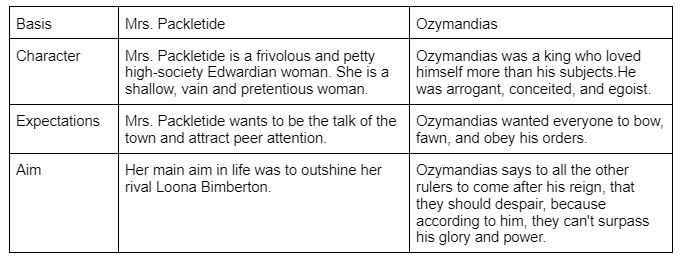
11. Imagine the traveller of the poem writes a diary entry, narrating his personal impressions about the trunkless statue and feelings about being in the antique land.
You may begin like this…
The moment I saw the vast stretches of sand I couldn’t contain my excitement. In
the midst of this sandy desert, I saw…
Ans-
Wednesday
24 May, 2023
18.30
Dear Diary,
The moment I saw the vast stretches of sand I couldn’t contain my excitement. In the midst of this sandy desert, I saw a ruined statue lying in the sands. The statue of a mighty king, Ozymandias who ruled his land with an iron hand. Even his damaged face bore the cruel expression and a chill went down my spine when I saw the words written below the statue. I shuddered as I read the lines carved beneath the statue. His vanity and haughtiness were evident in the remarks, but time had taught him that nothing was more potent than that. It was truly an eye opener for everyone. Time is a powerful force that wipes out everything.
ABC
Extract Based Questions
Extract-based questions are of the multiple-choice variety, and students must select the correct option for each question by carefully reading the passage.
A. Read the following extract and answer the questions that follow:
I met a traveller from an antique land
Who said: Two vast and trunkless legs of stone
Stand in the desert. Near them, on the sand,
Half sunk, a shattered visage lies.
(i) Whom did the poet meet?
Ans- The poet met a traveller.
(ii) Where was he coming from?
Ans- The traveller came back from an ancient land.
(iii) What did he see there?
Ans- The traveller saw the ruins of a huge statue.
(iv) Find a word from the given extract that means the same as “the manifestation, image, or aspect of something.”
Ans- Visage
B. Read the following extract and answer the questions that follow:
Whose frown,
And wrinkled lip, and sneer of cold command
Tell that its sculptor well those passions read
(i) Whose face lies on the sand?
Ans- King Ozymandias’s face lies on the sand.
(ii) What sort of expression did the face have?
Ans- The face had the harsh expression of a strong leader who must have been quite brutal and appeared to be rather haughty.
(iii) Who understood the emotions well?
Ans- The sculptor understood well the emotions or passions of the statue’s subject.
(iv) Find words in the given extract which convey that King Ozymandias was arrogant, conceited, and egoist.
Ans- Sneer of cold command
C. Read the following extract and answer the questions that follow:
Which yet survive stamped on these lifeless things.
The hand that mocked them and the heart that fed;
(i) Find a word in the given extract which means the same as “ impress a pattern or mark”
Ans- Stamped
(ii) Whose hands mocked them?
Ans- These were the hands of the sculptor who had so expertly chiselled and accentuated the contempt and brutality of a haughty ruler.
(iii) Whose expressions are carved on these lifeless things?
Ans- King Ozymandias’s expressions are carved on these lifeless things.
(iv) What message is conveyed through these lines?
Ans- The message conveyed here is: Ravages of time spares none. It highlights the variety of human grandeur and power that is reduced to dust.
D. Read the following extract and answer the questions that follow:
And on the pedestal these words appear;
“My name is Ozymandias, king of kings:
Look upon my works, ye Mighty, and despair!”
(i) What was carved?
Ans- A small introduction of the king and a message for all was carved on it.
(ii) Find a word in the given extract which means the same as “ the base or support on which a statue, obelisk, or column is mounted. “
Ans- Pedestal
(iii) Explain: Look upon my works, ye Mighty, and despair?
Ans- According to Ozymandias, his contemporaries should consider his accomplishments and authority and feel inferior to him. This shows that he wants to look down upon all the other rulers and considers himself supreme.
(iv) What do the words written on the pedestal reflect about Ozymandias?
Ans- It portrays Ozymandias as a haughty and conceited ruler. He wants to demonstrate his eminence and immortalise his significant accomplishments.
E. Read the following extract and answer the questions that follow:
Nothing beside remains. Round the decay
Of that colossal wreck, boundless and bare
The lone and level sands stretch far away.
(i) Why does he say ‘nothing beside remains’?
Ans- Once upon a time, there was a vast kingdom. But no trace of it was left now. Hence, the poet says that ‘nothing beside remains’.
(ii) Find a word in the given extract which means the same as “extremely large or great.”
Ans- Colossal
(iii) Explain the last line.
Ans- Every remnant of the powerful kingdom of the most powerful of all rulers has been destroyed by the ravages of time. There was nothing now but a vast desert landmass.
(iv) What is the poetic device used in the second line?
Ans- Alliteration.
Short Answer Questions
In this post we are also providing important short answer questions from Chapter 9 Ozymandias (Poem) for CBSE Class 10 exam in the coming session
Q1. What is the setting of the poem, ‘Ozymandias’?
Ans. The setting of the poem Ozymandias is an antique land. The traveller is describing his encounter with two enormous, trunkless stone legs on the desert sands. There were just expanses of sand around, and this ancient region showed no signs of human civilization.
Q 2. How can we say that the sculptor was a master artist?
Or
“The hand that mocked them and the heart that fed.” Whose hand and heart has the poet referred to in this line?
Ans. “The hand that mocked them” seems to be the sculptor’s hand, delineating the vain glory of his subject in “these lifeless things”; and “the heart that fed” must be Ozymandias’ own, feeding on perhaps its own arrogance.The shattered statue of Ozymandias had a scowl and sneer of icy authority on its visage. The king’s haughtiness was evident in the knit brow and wrinkled mouth. The accuracy with which the sculptor had caught all the subtle facial details of the haughty ruler was indicative of his skill.
Q3. Bring out the irony in the poem.
Ans. The irony in the poem lies in the fact that the mighty ruler had the following words engraved on his statue “My name is Ozymandias, king of kings; Look upon my works ye Mighty and despair!”
The haughty remarks and sneer on its face stand in stark contrast to the statue’s present state.
The king may have been powerful during his reign, but after his death, his legacy is at the mercy of the ravaging forces of nature. His former magnificence is now reduced to two legs raised and a broken face. This brings out the irony of the poem.
Q 4. What is the theme of ‘Ozymandias’?
Ans. The central theme of the poem is the transience of glory, as well as power. It also taps on the themes of the futility of life, the fate of history, ravages of time, antiquity, and impermanence. The main theme is introduced in the very beginning where Shelley’s speaker describes the “colossal Wreck” of the statue of the great king Ozymandias which is now half sunk in the lone, barren desert.
Q 5. What does sand symbolise in the poem “Ozymandias”?
Ans. In the poem, sand is a symbol of nature’s power and also of time itself. The statue and all of Ozymandias’ creations have been destroyed by erosion and buried beneath the sand as a warning that no matter how impressive human efforts may be, nature has the power to undo them all. Because it destroyed the statue over time, and because of the idea of sand in an hourglass, sand also represents time itself, which has similarly worn down and eventually buried Ozymandias’ empire.
Q6. What does the statue symbolise in the poem “Ozymandias”?
Ans. The statue of Ozymandias has a few different symbolic meanings. First, it is a physical representation of the power of human political institutions.
The statue also symbolizes the power of art. Through the sculptor’s skill, the statue captures and preserves the “passions” of its subject by stamping them on “lifeless” rock. And the statue also symbolizes the way that art can have power beyond the intentions of even those who commission it.
Q 7. “Tell that its sculptor well those passions read
Which yet survive, stamped on these lifeless things”
What do you understand by the word “passions” in the above lines?
Ans. “Passions” refers to Ozymandias’s emotions, and in particular, his arrogance, hatred, and sense of superiority. The sculptor originally read those “passions” on Ozymandias, and then carved them onto the stone, where they could be likewise read by passersby like the traveller who describes the statue to the speaker.
Q 8. Who is the speaker in the poem “Ozymandias”?
Ans. The poem’s primary speaker is anonymous and genderless, and all Shelley tells us about the speaker is that the speaker “met a traveller from an antique land.” The poem purposefully omits information regarding the speaker’s opinions of the traveller, of Ozymandias, and of the destruction of Ozymandias’s achievements.
Q 9. Describe the statue of Ozymandias in the desert.
Ans. The statue was severely damaged. Two enormous, stone legs with no trunk were present. The statue’s head lay on the ground, partially buried in the vast and isolated desert sands. The statue’s fractured pieces indicated that they were formerly part of a tremendously strong but ruthless and haughty tyrant. The massive forces of time had reduced the tyrant and his statue to oblivion.
Q10. Comment on Ozymandias’ pride?
Ans. In the inscription on the pedestal Ozymandias calls himself the “king of kings”. Ozymandias thinks pretty highly of himself and of what he’s achieved, both politically and artistically. The fact that he commissions this “colossal” statue with “vast legs” points to his sense of pride.
Long Answer Questions
Q1. “………boundless and bare
The lone and level sands stretch far away.”
Explain the above line with reference to the ravages of time in ‘Ozymandias.’
Ans. Human greatness and glory are transient. Kings erect sculptures and monuments to preserve their reputation and name in history. However, time wrecks havoc. Glory fades with the passing of time. The statue of Ozymandias is in ruins. Although the words carved on it show how powerful he is, power, hubris, and human pride are all transient.
His influence and accomplishments are for nothing. Time’s ravages spare no one. Ozymandias regarded himself as a deity and desired to be remembered forever through this piece of art (statue). Dust was all that was left of him for future generations to witness. His broken statue and disfigured visage depict the tragic consequences of human pride.
Ravages of time spare no one.Neither the powerful King who commissioned the statue to be built, nor the sculptor who built the statue with great passion, nor the statue itself. All three are toppled by mere grains of sand.
Q2. Bring out the theme of Shelley’s poem, ‘Ozymandias.’
Or
“The poem, ‘Ozymandias’ illustrates the vanity of human greatness.” Comment.
Ans.
One of Shelley’s most famous works, “Ozymandias” describes the ruins of an ancient king’s statue in a foreign desert. The themes in the poem are-
1. The Transience of Power
The poem goes on to explain that time not only destroyed this statue, it also essentially erased the entire kingdom the statue was built to overlook. All that remains of the statue are two “vast” stone legs standing upright and a head half-buried in sand, along with a boastful inscription describing the ruler as the “king of kings” whose mighty achievements invoke awe and despair in all who behold them. The poem implicitly critiques such power through its suggestion that both great rulers and their kingdoms will fall to the sands of time.
2. The Power of Art
“Ozymandias” famously describes a ruined statue of an ancient king in an empty desert. Although the king’s statue boastfully commands onlookers to “Look on my Works, ye Mighty, and despair,” there are no works left to examine: the king’s cities, empire, and power have all disappeared over time.
Although the statue is a “wreck” in a state of “decay,” its individual pieces show the skill of the sculptor and preserve the story of Ozymandias. The fragments interpret and preserve the king’s personality and show onlookers throughout history what sort of a man and leader Ozymandias truly was. These fragments, then, are examples of art’s unique ability to capture and relate an individual’s character even after their death. In fact, the poem explicitly emphasizes art’s ability to bring personalities to life.
3. Man Versus Nature
The statue is notably found in a desert, a landscape hostile towards life. That the statue is “trunkless” suggests sandstorms eroded the torso or buried it entirely, while the face being “shattered” implies humanity’s relative weakness: even the destruction of a hulking piece of stone is nothing for nature.
Ozymandias may be the king of kings, but even kings can be toppled by mere grains of sand.
Q3. Time brings the greatest of the great to their knees. How is this true of King Ozymandias?
Ans. P.B. Shelley wrote the sonnet titled Ozymandias. It communicates the message that human greatness and glory are transient. The monuments and statues erected by the rulers to preserve their name and reputation are destroyed over time. The poem therefore illustrates the vainness and transience of human grandeur and greatness. A renowned Egyptian king, Ozymandias created the monument in order to preserve his renown and name. His power and majesty faded with the passing of time.
A traveller from Egypt discovers the king Ozymandias statue that is shattered. He discovers the statue’s two enormous, trunkless legs on a platform in a desert. The broke statue’s face is nearby, partially buried. He observes the statue’s haughty attitude and sense of superiority. The king’s emotions were captured on the statue’s face by the artist’s hand. The following words were written on the pedestal: My name is Ozymandias, king of kings’ The lines show that even though Ozymandias was a king of kings, he was unaware that human hubris and pride do not endure for very long and that time eventually drags even the best of the great to their knees. Death is a sure leveller.
Q4. What is your impression of Ozymandias as a king?
Ans. In his day, Ozymandias was a powerful monarch. He was regarded as strongest of the strong kings. He had fought numerous battles, brought in many riches, and grown his kingdom into an enormous one. His contemporaries were humbled by his accomplishments when they witnessed the palaces he constructed and the example he established for them.
The broken head’s expression suggests that the man was a harsh ruler who was exceedingly haughty and looked down on his subjects with disdain. But time did not spare him. His immense realm was covered in dust when he died, leaving no trace behind.
Ozymandias had believed that while he himself would die, he would leave a lasting and intimidating legacy through everything he built. Yet his words are ultimately empty, as everything he built has crumbled. The people and places he ruled over are gone, leaving only an abandoned desert whose “lone and level sands” imply that there’s not even a trace of the kingdom’s former glory to be found. The pedestal’s claim that onlookers should despair at Ozymandias’s works thus takes on a new and ironic meaning: one despairs not at Ozymandias’s power, but at how powerless time and decay make everyone.
Q5 Critically appreciate the poem “Ozymandias”.
Ans. “Ozymandias” was written by P.B. Shelly. The poem is a sonnet based on Greek history.
The speaker tells that he met a traveller who returned from an ancient country. The traveller saw a broken statue in the desert. The statue’s two legs stood on the pedestal. The body was not upon the two legs. Near them was lying the shattered face of the statue. There were frowns. sneer and expression of cruel authority on the face. it seemed that the person who made the statue could understand the king’s character well and took every care to reflect it on stone. Though the sculptor and the king died long back, the broken statue still reflects the pride and cruelty of the king.
“Ozymandias” is a masterful sonnet. It focuses mostly on one metaphor: the broken, demolished monument in the barren desert, with its haughty, passionate expression and lunatic inscription (“Look on my works, ye Mighty, and despair!”). Ironically, the claim of the once-great king has been proven false; all of Ozymandias’s creations have crumbled and vanished, his civilisation is no more, and everything has been reduced to dust by the impersonal, indiscriminate, and destructive power of history. The demolished statue now serves as a stark reminder of one man’s arrogance and a potent metaphor for the insignificance of humans in the grand scheme of things. First and foremost, Ozymandias serves as a metaphor for the transient nature of political power. However, Ozymandias is not just a representation of political authority; it may also serve as a metaphor for the arrogance and vanity of all humankind.
Also See:
- Two Gentlemen of Verona Question Answers | Class 10 Communicative English chapter 1
- Mrs Packletide’s Tiger Question Answers | Class 10 Communicative English Chapter 2
- The Letter Question Answers | Class 10 Communicative English Chapter 3
- A Shady Plot Question Answers | Class 10 Communicative English Chapter 4
- Patol Babu, Film Star Question Answers | Class 10 Communicative English Chapter 5
- Virtually True Question Answers | Class 10 Communicative English Chapter 6
- The Frog and the Nightingale Question Answers | Class 10 Communicative English Chapter 7
- Not Marble nor the Gilded Monuments Question Answers | Class 10 Communicative English Chapter 8
- Ozymandias Question Answers | Class 10 Communicative English Chapter 9
- The Rime of the Ancient Mariner Question Answers | Class 10 Communicative English Chapter 10
- Snake Question Answers | Class 10 Communicative English Chapter 11
- The Dear Departed Question Answers | Class 10 Communicative English Chapter 12
- Julius Caesar Question Answers | Class 10 Communicative English Chapter 13
- CBSE Class 10 English Communicative Important Questions
- CBSE Class 10 English Literature Reader (Communicative)
- CBSE Class 10 English Communicative word meanings
- CBSE Class 10 English Communicative Study Guide
- Character Sketch of Class 10 English Communicative
- Descriptive Writing Class 10 Format, Examples
- Class 10 Communicative English Syllabus
- Email Writing Class 10, 12 Formal, Informal Email Writing Format
- Article Writing for Class 10
